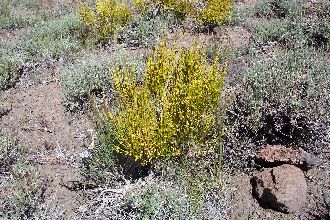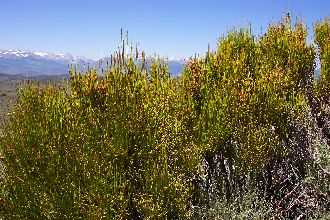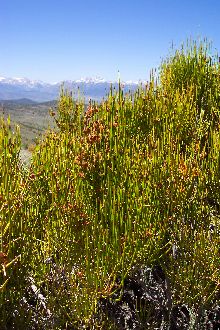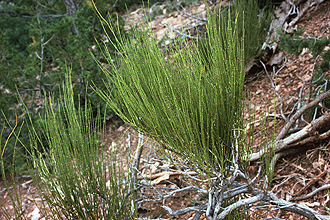Mormon Tea
Scientific Name: Ephedra viridis Coville
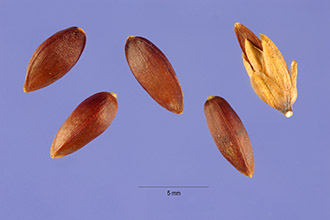
| General Information | |
|---|---|
| Usda Symbol | EPVI |
| Group | Gymnosperm |
| Life Cycle | Perennial |
| Growth Habits | Shrub |
| Native Locations | EPVI |
Plant Guide
Alternative Names
Mormon tea, jointfir
Use
Ethnobotanic: Green ephedra was traditionally used as a beverage and medicine. Native Americans made flour and a coffee-like beverage from the seeds. The Sierra Miwok and Owens Valley Paiute made an aromatic tea from the slender twigs by boiling them. This plant is still highly valued as a beverage today by many tribes and it is utilized as a tonic and blood purifier. The twigs were mixed with the inner bark of Purshia tridentata to make a tea for drinking by the Shoshone to treat gonorrhea. The Hopi used the plant in the treatment of syphilis. The Paiute and Shoshone also used a steeped tea made from the twigs as a regulator for kidney or sometimes bladder disorders. Washoe women imbibed a tea for delayed or difficult menstruation. The Kawaiisu of California steeped a tea for backache. The Navaho of Arizona gathered the twigs and leaves and boiled them with alum to produce a light-tan color. Brother Alfred Brousseau © Brother Eric Vogel, St. Mary’s College @ CalPhotos The vivid green foliage presents a striking contrast to an often-dull gray desert environment. It has been widely planted as an ornamental. This species is used in seed mixtures for re-vegetating depleted game ranges in the mountain shrub and juniper-pinyon types and optionally in the sagebrush type in Utah. Characteristics and qualities also are suited for soil stabilization and highway and park beautification. Wildlife: The mountain quail eats The seeds of Ephedra species and the plant is browsed by deer, bison, and antelope.
Status
Please consult the PLANTS Web site and your State Department of Natural Resources for this plant’s current status, such as, state noxious status and wetland indicator values.
Description
General: Ephedra Family (Ephedraceae). Green ephedra is a dioecious, scraggly shrub rarely more than 60 cm to 150 cm high. The naked seeds are the features, which places Ephedra with the classical group, the gymnosperms. The microsporophylls are similar to the stamens of the flowering plant; they also correspond with the spore-bearing scales in the male cone of a pine tree (Benson and Darrow 1981). The intricate network of brittle, practically leafless, bright green branches is the salient feature of the plant. The leaves are scale-like, 2 to 3 mm long, the bases and middle portions conspicuously dark brown, the rest light green and tending to be membranous, all but the bases falling away with age. In the springtime, the male plant becomes a conspicuous mass of yellow clusters of pollen sacs, and the green ovules (later brown seeds) are an obvious but less conspicuous feature of the female plant. At the Tucson PMC, green ephedra begins flowering in mid-to late-April. The pollen cones are spheroidal and 3 to 4 mm in diameter. The pollen sacs are relatively large, 0.5 mm long and 0.5 to 0.6 mm broad, and are practically lacking stalks. The ovulate cones have stalks 2 to 10 mm long, ovoid, and 5 to 7 mm long. The cone scales are in about 3 to 5 pairs, not membranous, and ovately shaped. They are green at the middles, lighter colored and thinner toward the margins, 2 to 5 mm long, and not stalked. The seeds are more or less boat-shaped, the flat "deck" of each facing the other member of the pair. They are dark greenish lead color, 5 to 7 mm long, about 2 to 2.5 mm broad, and not beaked (Benson and Darrow 1981). At the onset of the flowering period, plants bearing ovules exert a structure called a micropylar tube at the apex of the ovule. The micropylar tube allows the ovule to produce and display a small droplet from the exerted end of the tube. This droplet is called a pollination droplet and it serves as a receptacle for airborne pollen (Pater 1991).
Distribution
Green ephedra occurs on rocky or sandy slopes and plains in such plant communities as the lower California oak woodland, Joshua tree woodland, the northern juniper-pinyon woodland, the sagebrush desert and higher creosotebush deserts, and the desert grassland from 3,000 to 7,000 feet (915-2135 m) elevation. Common associates include creosote bush (Larrea tridentata), shadscale saltbush (Atriplex confertifolia), four wing saltbrush (A. canescens), big sagebrush (Artemisia tridentata), galleta (Hilaria jamesii), sand dropseed (Sporobolus cryptandrus), Utah serviceberry (Amelanchier utahensis), junipers (Juniperus spp.), and pinyons (Pinus spp.). The plant occurs naturally in Arizona deserts from the northern Mohave to Apache and northern Yavapai Counties at elevations of 3,000 to 7,000 feet (915-2135 m) (Benson and Darrow 1981). In California, the plant is found east of the Sierra Nevada from Lassen County southward to the mountains of Inyo County, and westward through the mountains of Kern County to eastern Ventura County, and thence southeastward to the mountains of southern San Bernardino county and the Western edge of the Colorado desert. Green ephedra extends into southwestern Wyoming, northern and central Nevada, southward to the Charleston Mountains, Clark County, Utah, except the northernmost part, and western Colorado (Benson and Darrow 1981). For current distribution, please consult the Plant Profile page for this species on the PLANTS Web site.
Establishment
Adaptation: Green ephedra is tolerant of calcareous, weakly saline, and slightly saline-alkaline (sodic) sites and it is sometimes found growing in clayey soils, It thrives in dry, well-drained sites and it is intolerant of wet sites and poor drainage, The plant is drought-resistant, markedly so after initial seedling establishment, Local plant materials are winter-hardy, Distant southern or lower altitude seed sources may be frost-sensitive, especially in the seedling stage, Ephedra sites are not commonly burned due to sparse, discontinuous fuels but some plants survive wildfire and spread by roots, Green ephedra is more vigorous in full sunlight but it also grows in partial shade of open woodlands, Plants are weakly competitive due to slow growth rate compatible with other shrubs and herbs, but more so after seedlings are firmly established (Pater 1991), General: Harvest the seeds by knocking them from the shrubs into containers or onto a dry, clean canvas using an office clipper seed separator, A Shop-Vac vacuum cleaner also has potential as a harvesting tool, Seed quality is not standardized, There is 90% purity, about 60% germination, 54% Pure Live Seed (PLS), and an estimated 25,000 seeds per pound (Pater 1991), Propogration by seed: Plant seed 1 to 2 cm deep; preferably by drilling in a well prepared, firm seedbed, Always mix the seeds with other species when re-vegetating game ranges to help control weeds and counterbalance slow rates of growth and establishment, One-half to one pound per acre of seed is used in 17 to 19 and 28 to 30 pounds per acre total seed mixes when drilling and broadcasting, respectively, Seeding can be sown by airplane on disked or plowed lands or such seeded areas can be anchor-chained when no site preparation proceeds seeding, Plant before the growing season with soil moisture most dependably adequate for good germination and seedling establishment, Seedings are made in late fall, early winter, or spring in intermountain areas (Pater 1991), About half of the seed will germinate in 5 to 12 days, and most germination is completed in 14 days in lab tests, Alternating 59 degree F to 87 degrees F (15,0-30,5 degrees C) day and 36 degrees F to 41 degrees F (2,2-5,0 degrees C) night temperatures are optimal for germinating seed, Use soil moisture sensors to measure the soil moisture of Mormon Tea., Constant 55 degrees F (12,7 degrees C) also gave good germination, Germination may be improved by an after ripening period, Results from Utah game range revegetation evaluations suggest seedling vigor and growth rate are rather weak; plants take five to ten years to attain two foot heights, Germination was reduced in -4 to -16 bars osmotic potential solutions; optimum was 0 to -4 bars (Pater 1991),
Management
Reduce plant competition and animal populations, if not already at low levels or excluded, during stand establishment, and balance animal populations with long term conservative usable herbage supply (Pater 1991). Cultivars, Improved and Selected Materials (and area of origin) EPVI is somewhat available through native plant seed companies. Seeds and plants of selected Ephedra cultivars are available from many nurseries. It is best to plant species from your local area, adapted to the specific site conditions where the plants are to be grown. Contact your local Natural Resources
Conservation
Service (formerly Soil Conservation Service) office for more information. Look in the phone book under ”United States Government.” The Natural Resources Conservation Service will be listed under the subheading “Department of Agriculture.”
References
Benson & Darrow 1981. Trees and shrubs of the southwestern deserts. The University of Arizona Press, Tucson, Arizona. Curtin, L.S.M. 1984. By the prophet of the earth ethnobotany of the Pima. University of Arizona Press, Tucson, Arizona. Kearney, T.H. & R.H. Peebles 1960. Arizona flora. University of California Press, Berkeley, California. Martin, A.C., H.S. Zim, & A.L. Nelson 1951. American wildlife and plants: A guide to wildlife food habits. Dover Publications, New York, New York. Pater, M. 1991. Documentation of a plant accession selected for advanced testing. USDA, NRCS, Tucson Plant Materials Center, Arizona Reagan, A.B 1929. Plants used by the White Mountain Apache Indians of Arizona. Wisconsin Archeologist 8(4):143-160. Strike, S.S. & E.D. Roeder 1994. Ethnobotany of the California Indians. Volume 2. Aboriginal uses of California’s indigenous plants. Koeltz Scientific Books, Champaign. Train, P., J.R. Henrichs, & W.A. Archer 1941. Contributions toward a flora of Nevada, No. 33. Medicinal uses of plants by Indian Tribes of Nevada. USDA, The Division of Plant Exploration and Introduction, Bureau of Plant Industry. Washington, D.C. USDA, Natural Resources Conservation Service 1999. Range site descriptions, D30-1-D41-3. Arizona State Office, Phoenix, Arizona. Whiting, A.F. 1966. Ethnobotany of the Hopi. Museum of Northern Arizona, Flagstaff, Arizona.. Wyman, L.C. & S.K. Harris 1951. The ethnobotany of the Kayenta Navaho. University of New Mexico Publications in Biology 5. University of New Mexico Press, Albuquerque, New Mexico. Zigmond, M.L. 1981. Kawaiisu ethnobotany. University of Utah Press, Salt Lake City, Utah.
Plant Traits
Growth Requirements
| Temperature, Minimum (°F) | -18 |
|---|---|
| Adapted to Coarse Textured Soils | Yes |
| Adapted to Fine Textured Soils | No |
| Adapted to Medium Textured Soils | Yes |
| Anaerobic Tolerance | None |
| CaCO3 Tolerance | High |
| Cold Stratification Required | No |
| Drought Tolerance | High |
| Fertility Requirement | Medium |
| Fire Tolerance | High |
| Frost Free Days, Minimum | 150 |
| Hedge Tolerance | Medium |
| Moisture Use | Low |
| pH, Maximum | 8.0 |
| pH, Minimum | 7.0 |
| Precipitation, Maximum | 12 |
| Precipitation, Minimum | 6 |
| Root Depth, Minimum (inches) | 10 |
| Salinity Tolerance | High |
| Shade Tolerance | Intermediate |
Morphology/Physiology
| Bloat | None |
|---|---|
| Toxicity | None |
| Shape and Orientation | Erect |
| Nitrogen Fixation | None |
| Resprout Ability | Yes |
| Active Growth Period | Spring and Summer |
| C:N Ratio | Low |
| Coppice Potential | No |
| Fall Conspicuous | No |
| Fire Resistant | No |
| Flower Color | Yellow |
| Flower Conspicuous | No |
| Foliage Color | Green |
| Foliage Porosity Summer | Dense |
| Foliage Porosity Winter | Porous |
| Fruit/Seed Color | Brown |
| Low Growing Grass | No |
| Lifespan | Long |
| Leaf Retention | No |
| Known Allelopath | No |
| Height, Mature (feet) | 3.0 |
| Height at 20 Years, Maximum (fee | 3 |
| Growth Rate | Slow |
| Growth Form | Multiple Stem |
| Fruit/Seed Conspicuous | No |
| Foliage Texture | Medium |
Reproduction
| Vegetative Spread Rate | Moderate |
|---|---|
| Small Grain | No |
| Seedling Vigor | Low |
| Seed Spread Rate | Slow |
| Seed per Pound | 23545 |
| Fruit/Seed Persistence | No |
| Propagated by Tubers | No |
| Propagated by Sprigs | No |
| Propagated by Sod | No |
| Propagated by Seed | Yes |
| Propagated by Corm | No |
| Propagated by Container | Yes |
| Propagated by Bulb | No |
| Propagated by Bare Root | Yes |
| Fruit/Seed Period End | Summer |
| Fruit/Seed Period Begin | Spring |
| Fruit/Seed Abundance | Medium |
| Commercial Availability | Field Collections Only |
| Bloom Period | Mid Spring |
| Propagated by Cuttings | No |
Suitability/Use
| Veneer Product | No |
|---|---|
| Pulpwood Product | No |
| Protein Potential | Medium |
| Post Product | No |
| Palatable Human | No |
| Palatable Graze Animal | Low |
| Palatable Browse Animal | Medium |
| Nursery Stock Product | No |
| Naval Store Product | No |
| Lumber Product | No |
| Fodder Product | No |
| Christmas Tree Product | No |
| Berry/Nut/Seed Product | No |

